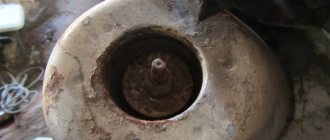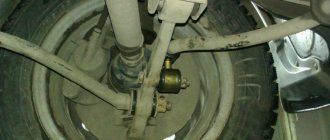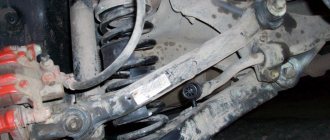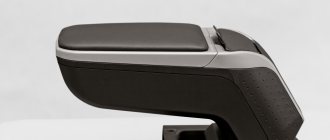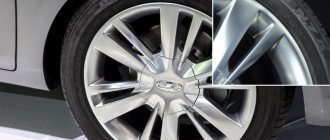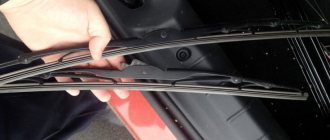Even at the stages of car development, it was known that the Vesta platform would be truly new, and not just another modernization of the VAZ 2108 suspension. Now that serial production of the sedan has already started, and the first samples have already been on test drives in various car magazines, more detailed details are being clarified about the chassis of the Lada Vesta.
The last adjustments to the suspension characteristics took place in winter in Spain, at the IDIADA training ground. Then a balance was found between comfort and car controllability. What happened?
Lada Vesta
The Lada Vesta SV station wagon is a long-awaited event that fans of the domestic automobile industry have been eagerly awaiting. The manufacturer offers the model in several configurations, giving the consumer the right to choose based on personal needs. At the same time, AvtoVAZ presented to the public two models in the back. In the car line they are listed as Vesta SV and Vesta Cross.
The vehicle is an original development of the manufacturer and is very different from previous versions. Technical characteristics provide the car with an excellent combination of handling, comfort and cross-country ability. The domestic station wagon is of considerable interest among car enthusiasts. And one of the reasons for this phenomenon is the front suspension of the car.
Lada Vesta suspension - design and distinctive properties
The domestically produced car was tuned at the Spanish IDIADA test site. The manufacturer has set itself the task of achieving ideal interaction between the car and the driver. As a result:
- Transport moves confidently in a straight line. When driving, you can feel the zero steering control very well.
- The car does not shake when cornering, as well as during braking and acceleration.
- While driving in any situation, good communication between the driver and the car is maintained.
The suspension of the Lada Vesta SV has built-in electronic assistants - ABS, EBD, ESP systems. Built-in stabilization makes movement easier and provides complete control over traction. The car is characterized by excellent cross-country ability, which is largely ensured by electronics and proper tuning of the car’s suspension. Simulated differential locking allows you to overcome off-road conditions. The company received a lot of positive feedback for this innovation.
Vesta front suspension
Front suspension
- This is a completely original design, which was developed from scratch. It is based on double-sided shock-absorbing struts filled with gas, on which coil springs, a stabilizer and lower arms are located.
The design uses a universal L-shaped lever, which replaced the longitudinal extension from previous versions. It copes well with various loads due to the use of a castor of 5 degrees. An eye-catching part of the suspension is a subframe with two support points for stretching.
➤ How to upgrade the suspension on Lada Vesta
Suspension tuning can give your car not only power and strength, but also personality.
Lada Vesta suspension tuning - options
The LADA Vesta SW entered the Russian automobile market in 2020. The manufacturer has released two options - Luxe and Comfort versions. The car is considered to be an original development of AVTOVAZ, which has a number of differences from previous models.
One of the tuning options
Features of the suspension on LADA Vesta
The Spanish testing ground IDIADA was chosen for the final configuration of the car parameters. The manufacturer's goal was to achieve the greatest possible interaction between the driver and the vehicle, and he really succeeded:
- the car moves confidently in a straight direction, while the driver accurately feels when the steering wheel is in the zero position;
- when cornering on uneven sections of the track, the steering wheel does not vibrate, and this guarantees constant feedback between the driver and the car;
- accelerating the car while entering a turn, the driver does not feel shaking;
- The new Lada model has a suspension that provides for the use of electronic systems - EBD, ABS and ESP. Thanks to the built-in stabilization system, control during a skid or drift is facilitated; the driver has full control of traction;
- The versatile Vesta has excellent cross-country ability, on the one hand, thanks to the correct suspension settings, and on the other, due to high-quality electronics. In order to overcome off-road areas, the manufacturer installed an imitation of differential locks - a new product for AVTOVAZ, which the owners have already noted as an improvement.
Suspension features
Front suspension features
The front suspension is based on gas-filled double-sided shock absorber struts, on which a series of coil springs, barrel springs and lower arms are installed. Stabilizers are located on pyramids. The longitudinal extensions from previous versions have been replaced by universal, L-shaped arms that can withstand heavy loads in any direction thanks to a five-degree caster.
Studying the part in detail, one can note something in common with the way the front-wheel drive of Renault cars is designed. An interesting feature is the presence of a subframe, thanks to which the car has two points of support for stretch marks.
Front suspension
Special attention is paid to the rear suspension, in which the mechanism installed in RenaultZoo electric vehicles has been redesigned. Semi-independent suspension models differ from versions with extended beams; the suspension has longitudinal linked arms. The manufacturer decided to limit itself to installing domestic struts, and the shock absorbers were located in the arch, which increased driving comfort and safety. The spars reliably cover each rear suspension spring, which also increases ease of movement.
Rear suspension
What are the features of the Lada Vesta Universal suspension
Unfortunately, many cars produced by AVTOVAZ have problems with the chassis. The new Station Wagon models have a redesigned and improved suspension, mainly focusing on the front part of the part. The car boasts L-shaped levers. To create them, high-quality steel, a high-strength body and a subframe were used.
Tuning Lada Vesta suspension
The rear suspension of the Vesta SV uses the same design as the Sedan. Vesta suspension tuning involves improving the parameters of the shock absorber and springs, which allows it to cope with heavy loads. The manufacturer has reduced the size of the rear springs in the Vesta SV by 9 mm.
One of the tuning options
LADA Vesta SW – advantages and disadvantages
This is a new generation domestic car, which can be called progress for AVTOVAZ. Good handling, increased safety, many innovations and improvements - all this allows you to appreciate the car. However, there are also disadvantages:
- weak stabilizer struts;
- creaking and tapping of the rubber band after some time of use;
- increased susceptibility to corrosion of subframes at the place where silent blocks are attached. The reason is the increased pocket size.
Lada Vesta SW
Prices and quality: relationship
| Manufacturer | Cost, rub.) |
| Xmug | From 2100 |
| VTS | From 1600 |
| Fulcrum | From 2300 |
| Kayaba | From 1300 |
*prices are current as of 10/25/2018
You should not try to find the most inexpensive part - it may turn out to be of poor quality, and you will have to re-purchase a more expensive option. It is better to focus on well-known manufacturers who provide spare parts in the middle price category. Recently, low-quality goods have often been offered at inflated prices.
List of reliable online stores
| Shop | vendor code | Price, rub) | Reviews |
| https://plastmob.satom.ru/p/231078716-lada-vesta-klyki-perednego-bampera/ | 1200 | Nikolay: Fast delivery, the goods arrived well. Fully matches the photo. Maria: I ordered a gray bumper, but they sent me a black one, it took about a month to replace it. A lot of problems. Ivan: The prices here are very good, we don’t have these in the car market in our city, this is not the first time I’ve ordered – I’m happy with everything. | |
| https://lada-vesta-shop.ru/shop/tyuning/klyki-perednego-bampera-vts-vesta.html | 00-00002908 | 2100 | Valera: I bought something for my car, everything suited me both in size and color. Artem: I’ve been working with this store for a long time, orders arrive very quickly, the prices are good. Maria: I don’t have time to go shopping and look for parts, but I just sat down after work, ordered it and picked it up two days later - very convenient. |
| https://tuningdesign.ru/nakladka-na-perednij-bamper-splitter-vts-dlja-lada-vesta | vst-vts-sl | 960 | Sergey: I have a friend who works in a car repair shop - they get all the parts from here, they buy them in bulk because the price is good and the quality is excellent. Stepan: I didn’t like the fact that it’s impossible to contact the store, you need advice - don’t even try to write or call. Pasha: I can note that the quality corresponds to what is stated in the product description. |
| https://lada-vesta-shop.ru/shop/tyuning/yubka-perednego-bampera-vts-lada-vesta.html | 00-00002907 | 2520 | Marina: Nice store, fast service Arthur: The price indicated on the website may not correspond to reality; be prepared to be told a different price over the phone. Roman: I really like everything on this site – it’s clear, simple and fast |
| https://ladatuningshop.ru/yubka-perednego-bampera-dlya-lada-vesta | 3800 | Alina: There is a very large selection of different accessories for the car - everyone will find something to their liking. Oleg: I ordered two identical thresholds, the parts arrived in different lengths. I had to return one, it’s good that they replaced it quickly. Garik: This is not the first time I have ordered parts for Lada here - I am satisfied with the work of the site. | |
| https://topkontur-design.ru/shop/lada/lada-vesta/lada-vesta-bamper/vesta-ubka-vts.html | 2600 | Maxim: Prices are lower than in stores. The quality is often better. Lilia: Thanks to the store for fast delivery and excellent advice. Vladimir: I ordered a product here, and then found it on another site for 200 rubles cheaper. Not a big difference, but still. |
*prices are current as of 10/25/2018
Owner reviews
| Positive reviews | Negative reviews |
| Dmitry: “It seems to me that AVTOVAZ has outdone itself in the suspension - it doesn’t rattle, it works smoothly.” | Igor: “The suspension makes terrible sounds after a month of driving, although I only rode around the city and not off-road. Now I’ll have to go to the dealer and solve the problem.” |
| Serezha: “It’s a good pendant, I think that it doesn’t need to be supplemented with anything, at least at first. Then maybe something will have to be improved. But definitely not in one year.” | Grisha: “I didn’t notice much difference in the new and old models. If you drive a foreign car and then a Lada, there is a difference, but it’s all the same.” |
| Natalya: “I used to drive an old model Lada – the difference is very noticeable, the car runs smoothly and does not jerk on every pit.” | Svetlana: “The car was positioned as improved, but when driving on a country road, it trembles like an old version of LADA.” |
| Ulyana: “I can’t say anything bad - the manufacturer did a great job. The shock absorbers work very well, as do the springs.” | Pavel: “The shock absorbers failed after six months, I installed new ones, and it became much better. It was necessary to change immediately, like many other things.” |
Conclusion
The manufacturer has installed an improved suspension, but it has not yet been possible to achieve ideal results. Perhaps, when creating the next new product, all the shortcomings will be corrected, and the suspension will be able to compete with foreign cars.
In general, the car drives smoothly, noise during fast driving has been reduced as much as possible, and the sensitivity of the suspension has decreased.
Super suspension for Lada Vesta (Video)
remont-avtovaz.ru
Comparison of the suspension of the Lada Vesta sedan and station wagon
It so happened that for many years the weak link of VAZ cars was the chassis. In his new product, the manufacturer offered a revised and improved version of its predecessors. The bulk of the changes were made to the front suspension. Many new parts have appeared, such as a subframe to increase body strength, L-shaped levers made of high-quality steel.
The rear suspension designs are almost identical. Vesta SW has modified springs and shock absorbers, which increases strength properties and allows them to withstand increased loads. The rear springs in the CW model are 9 mm larger.
Replacing a part with your own hands: how to install a new ball on Vesta
The procedure for installing a new spare part is carried out according to an intuitive action scenario, however, if the sequence of instructions described below is not followed, difficulties may arise during subsequent maintenance. To replace the support you will need a set of sockets and a set of wrenches, screwdrivers of both types, a jack, a wooden hammer, and a chisel. It is also advisable to find a wooden beam and a plank, which will be useful in the future during repairs. Dismantling the ball joint occurs as follows:
- Before repairs, you need to take care of safety when servicing the car - we park the car on a level parking lot, and also install wheel chocks under the wheels of the rear axle. It is also necessary to engage first gear by moving the selector to the appropriate position and squeeze the handbrake lever;
- Next, we raise the front part of the vehicle, after placing a wooden plank under the jack to increase the coefficient of adhesion. Using a wheel wrench, unscrew the wheel bolts and remove the part;
- Next, use a hexagonal Torx to turn the strut pin and unscrew all the fixing nuts to free the stabilizer strut from the lower suspension arm;
- Then we unscrew the nuts and remove the crankcase splash guard and the side member protective casing, after which we unscrew the bolt securing the side member to the radiator transverse arm - this will facilitate the installation of the ball in the future;
- Now we proceed to dismantle the subframe mounts and remove the spar. Use a socket wrench or sockets to hold the ball joint pin and remove the assembled part from the steering knuckle;
- To complete the dismantling procedure, unscrew the lever hinge fasteners and remove the part.
The procedure for installing a new support follows these instructions in strictly reverse order. Before installation, it is also necessary to replace all damaged fixing fasteners, as well as the protective casing of the supports and side members if the old ones are damaged. If difficulties arise while unscrewing the fasteners, the areas where the metal has acidified need to be treated with WD-40 and repeat the procedure after half an hour.
If a ball joint on a car fails during replacement, it is recommended to replace parts in pairs on the entire front axle - this will increase the service life of the vehicle's chassis and increase the convenience and safety of driving.
Differences between the suspension of Lada Vesta SW and Lada Vesta SW Cross
The version with the Cross prefix differs not only in its external qualities, but also in its technical properties. Externally, the model looks strong and brutal. But driving performance does not always correspond to appearance. To justify the name of the model, the manufacturer decided to change some structural suspension components, but did not conduct experiments with the engine.
Vesta Cross pendant
has slightly different shock absorbers. Here they are more rigid, although they belong to the same type. Elongated and stiffer springs are installed. The developers also made some manipulations with certain settings. Changes in parameters have increased the sharpness of response to steering wheel control, and its position is more clearly felt. During speed, after a maneuver, the car quickly returns to its previous control positions.
Lada Vesta is a great achievement of the domestic manufacturer. Due to structural changes, the vehicle received higher handling and safety. This was achieved through the use of various innovations.
The car must meet modern safety requirements, and the suspension of the Lada Vesta is responsible for this. AvtoVAZ designers tried their best and created a fundamentally new front and rear suspension design that was not modernized from previous models. The handling, comfort and safety of driving a Lada Vesta depend on the quality of the suspension and what technical features.
According to AvtoVAZ, the front suspension design is independent, with double-acting gas-filled shock absorbers. The front suspension struts feature barrel coil springs, lower wishbones and an anti-roll bar mounted on a subframe.
There are two engine mounting points (stretch) on it. The other two remained on the spars. This can be seen from the front in the photo. The suspension device uses MacPherson struts, the same as on previous models. The front suspension of the Lada Vesta is completely original, two new parts have been added:
- L – shaped levers;
- Front subframe.
The use of new parts allowed:
- Significantly increase body rigidity;
- Improve driving comfort;
- Helped improve safety levels.
The steering rack, engine, suspension parts and some parts of the chassis are mounted on a subframe. Which is radically different from the fastening of units on previous models. The torsion bar was modified, and the anti-roll bars received a new design.
This made it possible to improve the energy intensity of the suspension, and the handling of the Lada Vesta became significantly better. The car received steering from Renault Megane. Vesta’s suspension has the main difference from previous models in the presence of an L-shaped lever with a castor of 5 0, which is clearly visible in the photo.
This device effectively absorbs transverse and longitudinal loads. The new suspension design provides a significant improvement in vehicle handling.
Lada Vesta suspension photo and characteristics of the rear and front suspension of the Lada Vesta
Unlike its predecessors, the Vesta platform is completely original, and not an improved modification of the VAZ G8. The manufacturer announced this at the model development stages.
At the moment, when the first “Vesta” has already rolled off the assembly line and has been taken for all sorts of test drives by automotive experts, we can take a closer look at the features of its chassis.
The last adjustments and tests that the Lada Vesta suspension underwent took place this winter at the Spanish IDIADA test site, after which the car acquired the optimal combination of comfort, handling and safety. As a result, we have the opportunity to evaluate the results of the work of automotive professionals.
Front suspension Lada Vesta
This part of the suspension is completely different from other front-wheel drive Lada models. It is radically different from all cars produced by the AVTOVAZ concern.
The main feature is the absence of the usual suspension braces, which the designers replaced with full-fledged levers with a ball pin. The Lada Vesta suspension is attached to the subframe using reinforced rubber-metal hinges. The type of struts is the classic MacPherson strut, common on foreign cars.
Vesta's front suspension is independent. Its main elements:
• Shock absorber struts (gas-filled, double-sided)• Barrel-shaped coil springs• Suspension arms• Anti-roll bar
In addition, the Vesta suspension is mounted on a subframe, on which the engine mount extension rests. The remaining two motor mounting points are located on the side members. Having looked at the photo of the Lada Vesta suspension, you can see that the levers are L-shaped and differ from the familiar “figure-of-eight” lever.
Their advantage is that they have a castor of 5 degrees and are able to withstand both longitudinal and lateral loads. This extends the service life of parts and improves driving comfort. In addition to this, the manufacturers used new steering knuckles, which significantly improved the car's maneuverability and handling.
Rear suspension
The Lada Vesta rear suspension, which was originally planned as an independent multi-link, has a semi-independent torsion beam, which is also used in other front-wheel drive Lada models.
At the last moment, engineers decided to reduce the cost of the car and installed this design on Vesta.
The rear suspension of the Lada Vesta consists of the following parts:
• Double-acting gas-filled shock absorbers • Trailing arms • Coil barrel springs
The rear suspension arms are elastically connected to each other using a transverse beam and a stabilizer bar. This type of suspension is called semi-independent, with linked arms. The suspension from the Renault Zoo served as the basis for the Lada Vesta. The developers slightly changed its dimensions, lengthening the beam, and thoroughly redesigned the structure. The car's shock absorbers were placed in the arches, and the springs were placed under the side members.
Suspension test in real conditions
Innovations have significantly improved the car's handling. The main difference between the suspension is the excellent combination of comfort, maneuverability and safety. The car responds perfectly to all the driver’s movements and allows for maximum mutual understanding.
Moving along a straight road, the driver clearly feels the zero position of the steering wheel, and during turns, he can fully control the entry trajectory. At the same time, during braking, increasing speed and other maneuvers, no shocks are felt in the steering wheel, as was the case in previous VAZ models.
When the road is rough, vibrations from the body are absolutely not transmitted to the steering wheel. It fits well in your hands and does not break out of your hands even with strong shaking. This ensures safety and confidence when driving, which is proven by numerous test drives of the new car.
vestatc.ru
Rear suspension device
The rear suspension of the Lada Vesta is the same as on Renault Megane cars. This diagram is provided by the Renault-Nissan concern. At the rear, the Lada has barrel-shaped coil springs on a transverse beam with spaced shock absorbers and brake drums.
A photo of the Vesta pendant gives an idea of the changes:
- The designers were the first to use a new arrangement of springs and struts with spaced mounting;
- The tuning was carried out using original technology at Renault's European factories;
- The rear track has been increased to 1510 mm, as a result of which the rear wheel arches have also been enlarged.
We can conclude that Vesta received a new suspension device capable of ensuring passenger comfort and, most importantly, a smooth ride. The suspension device is shown in the photo and consists of:
- Rear suspension beam;
- Barrel springs;
- Double-acting gas-filled shock absorbers
In addition to the described features, the suspension on the Lada Vesta has a number of other equally important innovations.
Suspension innovations
This use of electronic systems ABS, ESP and EBD allows for a number of advantages. First of all, the built-in stabilization system allows you to easily cope with skidding and drifting of the car while driving. It also allows you to control traction.
A correctly configured Lada Vesta suspension, together with electronics, allows you to simulate a differential lock, which allows you to easily overcome off-road conditions. If you find yourself in a difficult situation, the activated stabilization system can significantly improve the vehicle's maneuverability.
This technology was first used on Lada. The stabilization system received positive feedback from the owners. And now, no matter how difficult the road, Vesta can cope even with difficult off-road conditions.
In previous AvtoVAZ developments, the chassis is the most vulnerable point of the car. In the new Lada Vesta, the developers undertake to eliminate this problem. As the test results showed, indeed, the chassis of the Lada Vesta has undergone significant changes and improvements.
The new car has two completely new components added:
- Stretcher;
- L-shaped arms.
A subframe is a power unit that serves as protection and increases the strength level of the body. Installing such a component helps:
- Significantly improved safety levels;
- Increased driving comfort;
- Increased body rigidity.
Some main parts of the Lada Vesta chassis are mounted on the subframe: the steering rack, the main suspension components and the engine. The location of these units differs significantly from previous models.
The L-shaped levers on the Lada Vesta are analogues of the saber-shaped levers that are present on the Priora and Kalina models. Such levers have a triangular shape, which has the highest degree of rigidity among other geometric shapes. The components of the levers are made of high quality steel, and the steering knuckles are made of cast iron. The development has significant similarities with Renault, despite this, employees of the domestic plant claim that they are the authors of the L-shaped levers on the Lada Vesta.
Restaling rear suspension of Lada Vesta
The rear suspension of the Lada Vesta was borrowed from Renault Nissan in order to reduce the overall financial costs of production. The rear suspension on the car is a transverse beam with spaced springs and drum brakes. The experts chose the drum type due to the low cost and long service life of the components. In civilian modes of movement, drum brakes are not inferior in technical properties to disc brakes. In addition, in Lada Vesta the drum brakes are additionally protected from possible ingress of dirt and dust. The original rear suspension can last for about 120-150 thousand kilometers without any deformation.
The main differences in the structure of the front suspension of the Lada Vesta in comparison with previous VAZ models
The front suspension is installed on the Lada Vesta subframe. This placement increases rigidity, improves handling and minimizes noise and vibration. To improve handling, the steering rack was installed at the bottom. This action made it possible to influence the rotation of the wheels by the hubs. AvtoVAZ developers chose the path of unification: the electric version of the power steering was placed on the steering column, that is, it is not built into the steering mechanism, like in previous Lada models. The anti-roll bar has also undergone re-staling. At the moment it has a completely different look and additionally long racks have been added to it.
Wheelbase of Lada Vesta for any type of road surface
The wheelbase of the Lada Vesta sedan is 2570 mm. The track of the front and rear wheels is slightly different: front – 1495 mm, rear – 1502 mm. As for the ground clearance of the Lada Vesta, it varies significantly depending on the body type:
- Sedan – 178 mm;
- Hatchback – 180 mm;
- Station wagon – 190 mm.
Subject to the permissible load, the sedan's ground clearance will be 170 mm. The wheels of the Lada Vesta are practically no different from the previous development - Priora. Such technical characteristics allow you to move unhindered on country roads, which is especially important for residents of rural settlements.
Lada Vesta: front and rear suspension
The quality and technical features of the suspension are a very important detail for any car, including the Lada Vesta. The stabilization system feature, as well as other innovations in the suspension of the new sedan, became a real sensation for the Russian automobile industry.
In the process of creating the car, the developers had a goal - to create a suspension that was relevant for Russian roads on a platform that was not inferior in reliability and functionality to the best foreign models. The suspension for the Lada Vesta turned out to be a truly unique creation, created by Russian specialists.
Front Features
The front part of the Lada suspension has taken on the maximum of innovations. Let's look at these features in more detail.
Vesta front suspension features:
- The concept of architecture has changed, the suspension is arranged on a subframe. Thanks to this, rigidity indicators were increased, geometry accuracy increased, and vibration-acoustic properties were improved.
- The steering rack is now located at the bottom, thanks to which the wheel rods are directly connected to the hubs. This made it possible to improve the handling of the Lada and achieve real competitiveness in relation to foreign models;
- The castor angle is 5 degrees, the suspension is independent. MacPherson struts are used. There is a new stabilizer. The system is more sensitive than on previous models and provides smoother control.
The anti-roll bar has also been upgraded. The torsion bar has acquired a more advanced shape and is now equipped with long struts. This significantly improved the handling of the Lada.
The front suspension is maximally adapted to Russian roads and allows the Lada Vesta to confidently perform in any situation. According to the owners' reviews, the car's chassis is made to last, Vesta walks on the road very smoothly and even outperforms foreign competitors such as Hyundai Solaris and KIA Rio.
Rear suspension
In order to give an objective assessment of the chassis of the Lada Vesta, we study the suspension of the rear of the car. Everything is simpler here, everything is done according to the classical scheme.
But several innovations have been built into the rear suspension. Let's look at these changes in more detail:
- springs and struts are now arranged in a new, spaced-out way, and this is a serious step forward for Lada and for the entire Russian automobile industry;
- the suspension was tuned at the Renault factory using European technologies;
- It is worth noting that the rear track on Vesta was expanded to 1510 millimeters, due to which the rear wheel arches were enlarged.
We can conclude that Vesta’s body is equipped with a modern rear suspension, which means that now passenger comfort and a smooth ride will become integral qualities of the new Russian car.
About built-in technologies and stabilization system
In addition to the Vesta features listed above, it is worth considering a number of other innovations in the chassis, which are no less important. First of all, it is necessary to note the use of systems such as ABS, ESP, and EBD. In addition, the Lada Vesta has power steering from Nissan, and its braking system is equipped with components from Renault Logan and Renault Megane. Acting together, these factors give the car high status and reliability.
The new Lada Vesta has a built-in stabilization and traction control system. The system allows you to easily overcome various skids and drifts of the car while driving.
When the electronics in a car are correctly and professionally configured and are capable of simulating a differential lock, then the vehicle’s cross-country ability significantly improves. The Lada Vesta has just such a system and it is configured really effectively. Now you don’t have to worry about getting into mud, snow, uneven surfaces, or driving off to the side of the road. When the stabilization system is turned on, the Lada goes into all-terrain mode and is able to get out of a difficult situation.
This technology is being used for the first time and, judging by feedback from car owners, it actually works well.
Conclusion
After studying the numerous innovations that were used in the manufacture of the suspension, we can conclude that AvtoVAZ took the creation of the Lada Vesta very seriously. It's clear that close attention has been paid to more than just the engine and design. Creating a high-quality suspension and giving the car excellent driving characteristics indicates that the company cares about its reputation and thinks about its customers. The new stabilization system allows Vesta’s suspension to be considered revolutionary in the Russian automobile industry.
vestaxray.ru
“Robot” as a gearbox on Lada Vesta
Depending on the configuration, manual transmission and robotic transmission (AMT) were chosen as the gearbox on the Lada Vesta. This transmission combines the operating principles of an automatic transmission and a manual transmission. The main aspect in choosing this option is high operational reliability and long service life when compared with a conventional automatic transmission. The basis of the AMT is the traditional VAZ manual transmission; the “robot” was created jointly with German specialists from the ZF company. As tests of the Lada Vesta have shown, with a box of this type it is more difficult to move on an inclined road.
The production considered the possibility of installing a recoil mode, but in the future it was abandoned due to low efficiency. A unique development in the Lada Vesta is the presence of a special sensor that reacts to overheating of the unit. Both automatic and manual transmissions lack this function. Based on test results, it is known that such a transmission is ideally suited for domestic roads. With it you can move around both the city and the highway without any problems. In addition, some components were replaced with better ones. If we compare a “robot” with an automatic transmission, the first one is significantly lower in cost than the second one, but at the same time it is in no way inferior in functionality and technical capabilities.
The price for Lada Vesta in 2020 ranges from 514 to 650 thousand rubles, it all depends on the type of body and its configuration. Before purchasing, you can familiarize yourself in detail with the internal structure of the cabin and the appearance of the Lada Vesta in photos and videos.
— front struts for Lada Vesta. Pay attention to the mount; on the right there are racks from Granta.
Thanks to an “insider,” we learned that the new product will receive new gas struts produced by the Skopinsky AutoAgregate Plant. It is noted that all configurations will be on gas struts. Many will notice that Lada Granta \ Kalina in the luxury configuration, as well as on sports versions, have had gas-filled struts installed for a year now, but for Vesta they have a different design and settings, and the suspension itself is a development that has not yet been used on AvtoVAZ cars ( prepared for Project C).
For reference:
Gas-filled racks work harder, but are more stable and have a longer service life. Unlike their counterparts (oil-filled struts), the compensation chamber of these shock absorbers is filled not with ordinary air, but with gas, which is pumped into it under very high pressure - up to 28 atmospheres. Due to the high pressure, the shock absorber piston is always pressed. This makes it possible to react much faster to the shortcomings of domestic roads. Moreover, a single-tube shock absorber, unlike a hydraulic double-tube shock absorber, is cooled better and therefore operates more stable.
For comparison: this is what the front suspension struts look like for Lada Granta, Kalina and Priora.
We would also like to note the change in the handbrake on the Lada Vesta; now it is not the same as before, it is more adaptable, and it feels like it will not require constant adjustment.
Refinement of Lada Vesta. New car - old mistakes
Drivers often wonder if the Lada Vesta needs modifications. After all, this is a new car. Not everyone saw him live. As you know, our people are wary of new products, especially if they are products of the domestic automobile industry. This is due to persistent rumors about the low quality of our cars. Thanks to several not very successful models, AvtoVAZ has spoiled its reputation, and nothing good is expected from it.
At the same time, the new model turned out to be very good. Experts from Europe participated in its creation. Many developments were borrowed from the concern's partners. At the same time, the car also received a large number of new design elements developed specifically for it.
Troubleshooting
Revision of Lada Vesta
sometimes required. This is not surprising, the model is new. In this case, something unforeseen by the engineers is always revealed. The same thing happened with this car. Overall, there are few shortcomings:
- Knock of racks
. This problem occurs due to the insufficient length of the part. Therefore, when driving over uneven surfaces, a knocking sound is heard. It is unclear why the engineers did not pay attention to this problem when fine-tuning the car. Perhaps they were just in a hurry to put it on the assembly line. Starting in the fall, cars with completed suspension will be sold. On cars that have already been sold, dealers eliminate the problem by installing additional washers under the pillar; - Some cars experience leaking from the front doors after rain. The reason is a poorly secured seal. To eliminate this drawback, the door is disassembled and the glass is removed. The sealant is seated on the sealant, and everything is assembled in the reverse order;
- Short wipers
. Windshield wipers clean a small area of the windshield. This is not enough for normal control of the traffic situation. Therefore, drivers often replace standard wipers with longer ones.
These are the most common Vesta schools. Of course, there are other disadvantages. But they are quite rare.
Engine tuning
The power units on the Lada Vesta are quite powerful, but not everyone has enough of this. Therefore, some people are looking for ways to increase the car's throttle response.
The easiest way is to reflash the engine control unit. This allows, depending on the engine model and the program used to make changes, to increase power by 10-25 hp. Also, some craftsmen install a turbine. This also makes the engine more powerful. Technologically, this work is no different from that of previous AvtoVAZ models.
The main disadvantage of this modification is increased fuel consumption. Therefore, think about whether it makes sense to do this work.
External tuning
External tuning is the most popular. The main goal here is to give the car an unusual look, different from the rest. Some elements of body tuning may well improve aerodynamics. This applies primarily to the spoiler. If it is fitted exactly to the car, then fuel consumption will be reduced due to downforce.
Article on the topic “What is the difference between a wing and a spoiler.”
Now you can already find various decorative elements in stores. The door sill trims look best. This is explained by the design features of the Lada Vesta. You can also add deflectors. In general, you can find quite a lot of different linings for this model. But, if you want to remodel the body more thoroughly, you will have to wait. There are no tuning body parts on sale yet.
Airbrushing is especially successful here. You can apply any variety of styles here. Thanks to its modern appearance, it will look chic on any occasion. This is the first domestic car with such a good appearance.
Suspension tuning
. We have already described one of the chassis improvements above. In general, the suspension here is quite reliable. Most often, drivers change shock absorber struts. Here they are gas-oil, this allows the car to confidently stay on the road in any situation.
Lada Vesta suspension
Before this, a computer model of the Lada Vesta suspension appeared on the Internet, which is very different from previous AvtoVAZ models. The Just Lada community was the first to publish this information:
The designers finally moved away from the type of front suspension that had been used for the last 30 years (starting with the VAZ 2108) and moved on to a subframe and L-shaped arms attached to it and a steering rack, which was previously attached to the engine shield.
The rear suspension remains fundamentally the same - as on the vast majority of modern front-wheel drive vehicles (and on all LADAs with front-wheel drive), it is a semi-independent beam, but with one difference from previous AVTOVAZ products: the springs are now separated from the shock absorbers.
Revolution is ahead
The largest number of revolutionary innovations for VAZ were applied to the front suspension. First of all, this is a change in the concept of its architecture. For the first time on Lada cars, the front suspension is mounted on a subframe, which will increase its rigidity and geometry accuracy while simultaneously increasing vibration-acoustic characteristics.
No less revolutionary is the location of the steering rack, which has moved downwards, which eliminates the need to turn the wheels through levers - now the rods are connected directly to the hubs. This approach will significantly improve the car's handling characteristics, bringing them to the European level, which has been expected from VAZ products for several decades. Of the usual elements, only the electric power steering remains, which will be mounted on the steering column to simplify the design.
The Lada Vesta has a completely independent front suspension, with a castor angle of five degrees. MacPherson struts and L-shaped arms of our own design are used. Russian engineers also introduced a new stabilizer, which received a different shape, elongated struts and a different metal composition. The result is a much more sensitive system, which contributes to improved clarity and smoothness of control, as well as the behavior of the sedan on the road.
Despite the new layout, the developers managed to maintain an acceptable ground clearance (ground clearance) for Vesta, which for the sedan is 185 mm from the ground to the engine crankcase protection.
This means that the new product will feel quite confident on Russian roads. As for other figures, the wheelbase of the Lada Vesta is 2635 mm, the front wheel track is 1510 mm, and the distance between the rear wheels is exactly the same.
